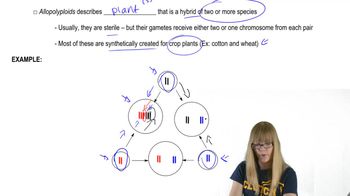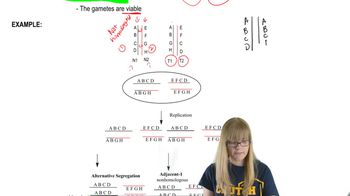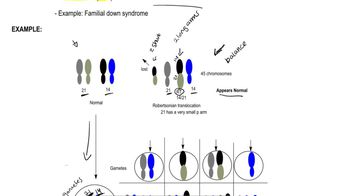Table of contents
- 1. Introduction to Genetics51m
- 2. Mendel's Laws of Inheritance3h 37m
- 3. Extensions to Mendelian Inheritance2h 41m
- 4. Genetic Mapping and Linkage2h 28m
- 5. Genetics of Bacteria and Viruses1h 21m
- 6. Chromosomal Variation1h 48m
- 7. DNA and Chromosome Structure56m
- 8. DNA Replication1h 10m
- 9. Mitosis and Meiosis1h 34m
- 10. Transcription1h 0m
- 11. Translation58m
- 12. Gene Regulation in Prokaryotes1h 19m
- 13. Gene Regulation in Eukaryotes44m
- 14. Genetic Control of Development44m
- 15. Genomes and Genomics1h 50m
- 16. Transposable Elements47m
- 17. Mutation, Repair, and Recombination1h 6m
- 18. Molecular Genetic Tools19m
- 19. Cancer Genetics29m
- 20. Quantitative Genetics1h 26m
- 21. Population Genetics50m
- 22. Evolutionary Genetics29m
6. Chromosomal Variation
Chromosomal Rearrangements: Translocations
Problem 24d
Textbook Question
A boy with Down syndrome (trisomy 21) has 46 chromosomes. His parents and his two older sisters have a normal phenotype, but each has 45 chromosomes.
Explain how this is possible.
 Verified step by step guidance
Verified step by step guidance1
<span>Step 1: Understand the typical chromosomal count in humans. Normally, humans have 46 chromosomes, which are arranged in 23 pairs. One of these pairs determines the sex of the individual, while the others are autosomes.</span>
<span>Step 2: Recognize the chromosomal abnormality in Down syndrome. Down syndrome, or trisomy 21, occurs when there is an extra copy of chromosome 21, resulting in 47 chromosomes in total.</span>
<span>Step 3: Consider the chromosomal count of the boy with Down syndrome. The problem states that the boy has 46 chromosomes, which is unusual for someone with Down syndrome. This suggests a different chromosomal arrangement or anomaly.</span>
<span>Step 4: Explore the possibility of a Robertsonian translocation. This is a type of chromosomal rearrangement that can result in a person having 45 chromosomes. In this case, two acrocentric chromosomes (such as chromosome 21) fuse at the centromere, forming a single chromosome. This can lead to a balanced translocation in the parents, who appear phenotypically normal but have 45 chromosomes.</span>
<span>Step 5: Explain how the boy could have Down syndrome with 46 chromosomes. If one of the parents carries a Robertsonian translocation involving chromosome 21, they can pass on the translocated chromosome along with a normal chromosome 21 to the child. This results in the child having two normal chromosome 21s and one translocated chromosome, effectively having three copies of chromosome 21 material, leading to Down syndrome.</span>
Recommended similar problem, with video answer:
 Verified Solution
Verified SolutionThis video solution was recommended by our tutors as helpful for the problem above
Video duration:
3mPlay a video:
Was this helpful?
Key Concepts
Here are the essential concepts you must grasp in order to answer the question correctly.
Chromosomal Abnormalities
Chromosomal abnormalities occur when there is a deviation from the normal number or structure of chromosomes. In the case of Down syndrome, also known as trisomy 21, an individual has three copies of chromosome 21 instead of the usual two. This can happen due to nondisjunction during meiosis, where chromosomes fail to separate properly, leading to gametes with an abnormal number of chromosomes.
Recommended video:
Guided course

Chromosome Structure
Nondisjunction
Nondisjunction is the failure of homologous chromosomes or sister chromatids to separate properly during cell division. This can occur during meiosis, resulting in gametes that have an extra chromosome or are missing one. If such a gamete participates in fertilization, it can lead to conditions like Down syndrome, where the resulting zygote has an abnormal chromosome number.
Recommended video:
Guided course

Allopolyploidy
Phenotype vs. Genotype
Phenotype refers to the observable characteristics or traits of an individual, while genotype refers to the genetic makeup. In this scenario, the boy with Down syndrome has a distinct phenotype due to his extra chromosome, while his parents and sisters, despite having 45 chromosomes, may have a normal phenotype if they are carriers of a chromosomal rearrangement or if they have a balanced translocation that does not affect their observable traits.
Recommended video:
Guided course

Gamete Genotypes

 12:42m
12:42mWatch next
Master Reciprocal Translocation with a bite sized video explanation from Kylia Goodner
Start learningRelated Videos
Related Practice



